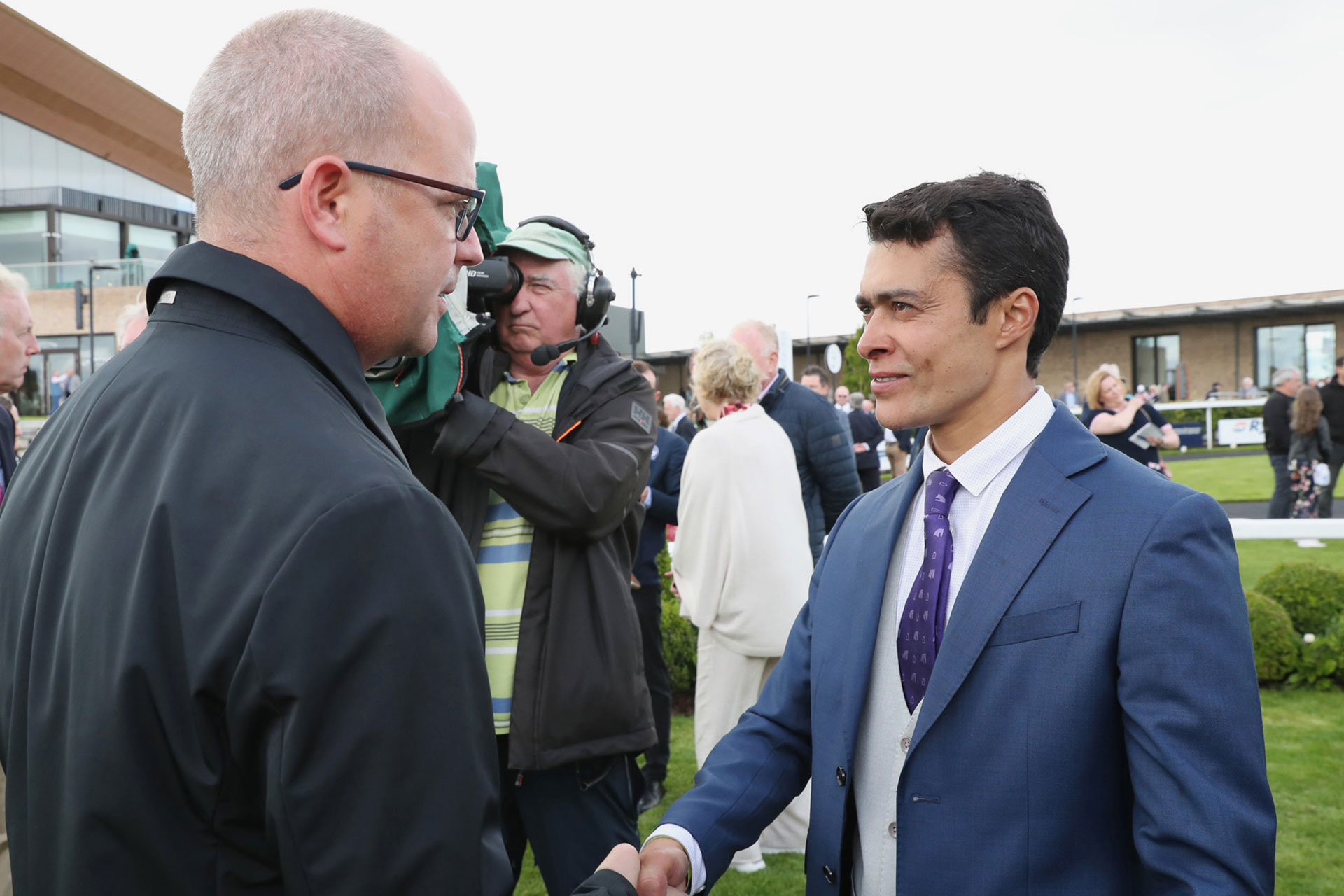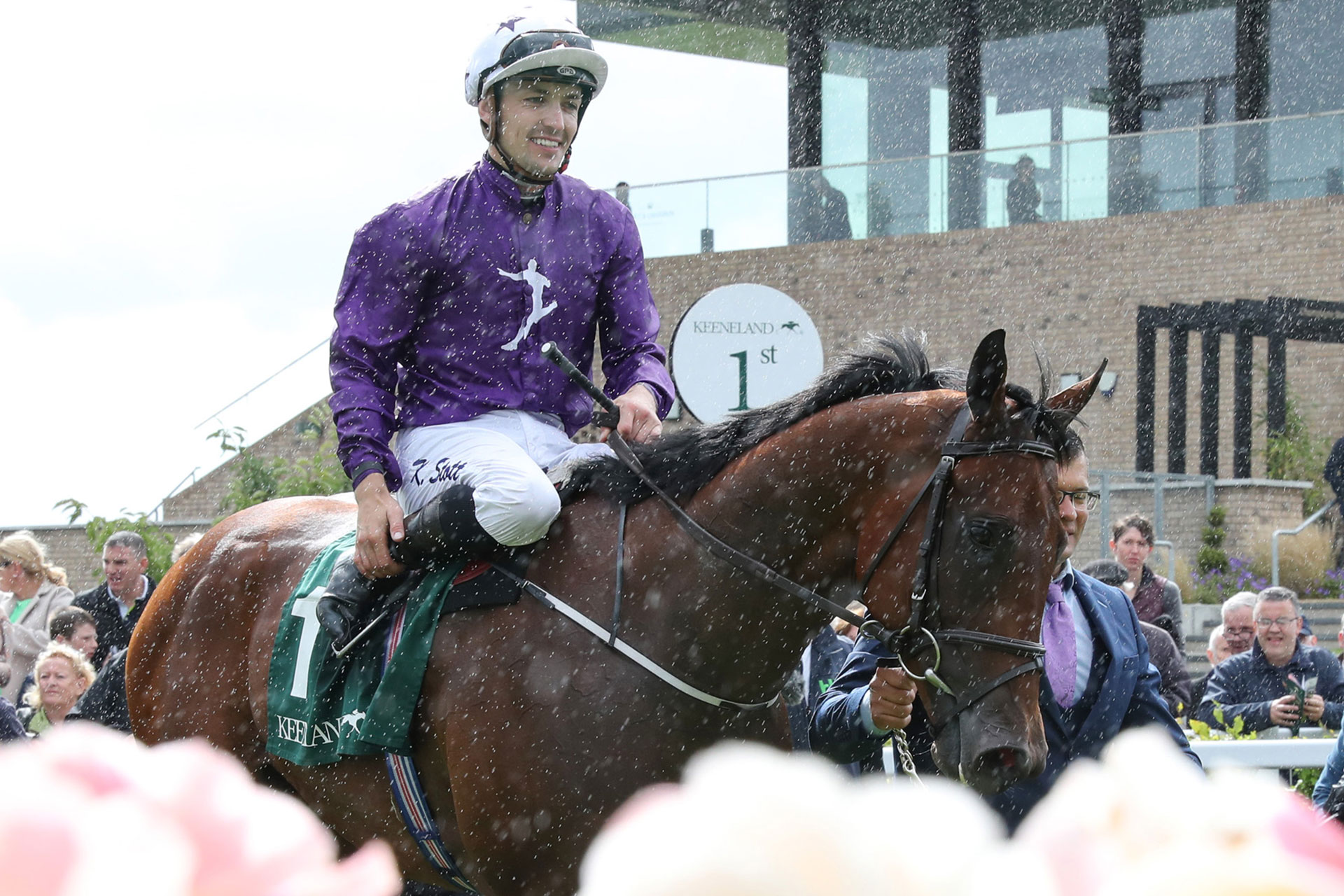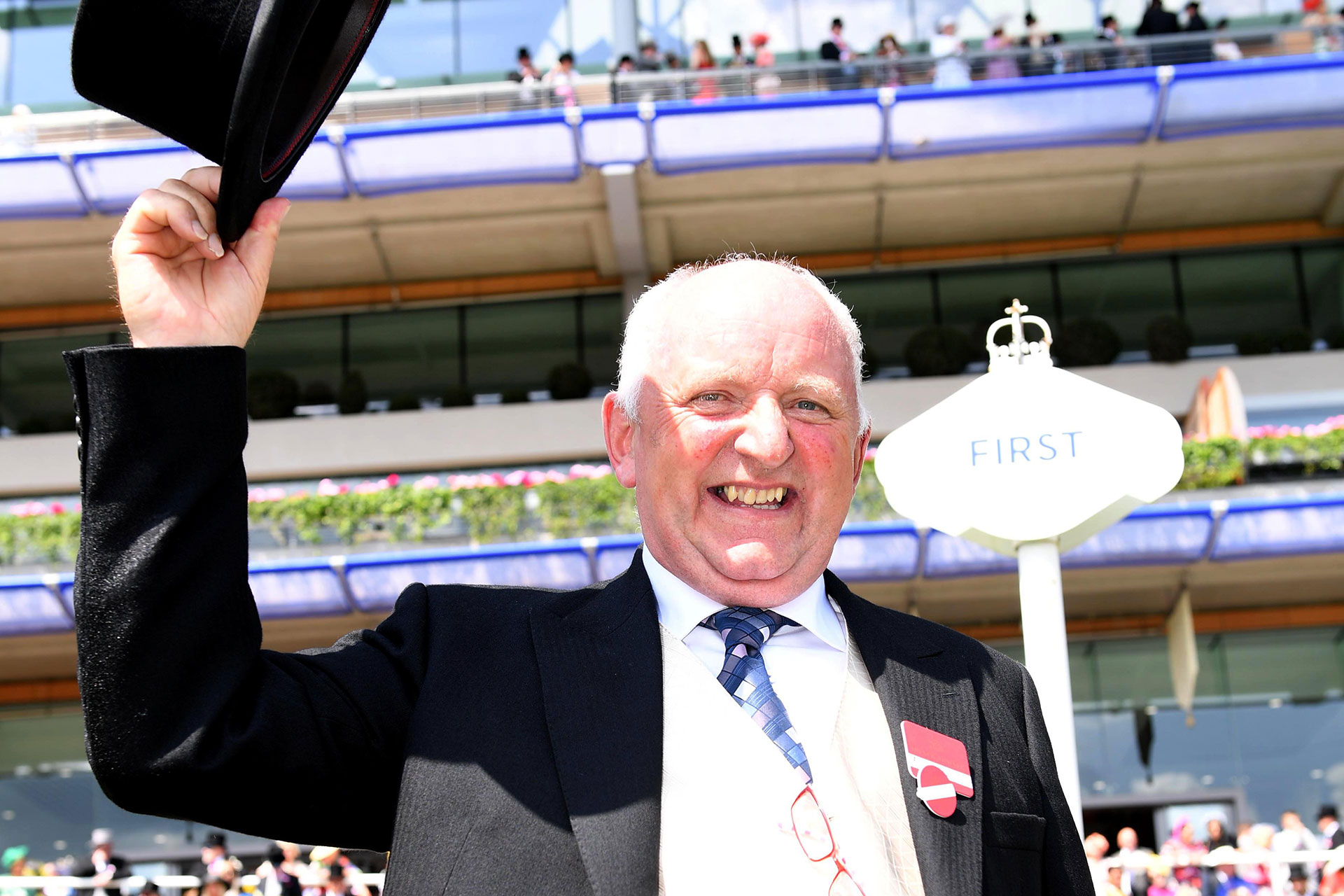Adrian Murray
Hats off
One of those rare people you feel better for having met, it is no surprise that
Adrian Murray’s Group 1 breakthrough was a popular one
Words: Guy Williams • Photos: Healy Racing & Caroline Norris
Modest man that he is, Adrian Murray sounded pleasantly surprised that any scribe would want to meet him in person, rather than interview him over the telephone. We could meet at his second yard. “Coming from Mullingar? Go two, maybe three miles out the Ballymahon road and you’ll see the barn and the gallops on your right. But ring me that morning. I’ve a head like a sieve.” Getting to Mullingar was the easy bit. The town is now surrounded by industrial estates. Ten minutes later we found the Devil’s Arms. As for signs to Ballymahon – or indeed anywhere – forget it. We retreated in disorder, ringing Adrian to apologise. On learning our immediate destination – Tullamore – he said he would meet us at the filling station on the Tullamore side of Kilbeggan in 20 minutes. And so – God bless him – he did.
Adrian Murray’s story of how he mutated from hunting and showjumping to training two-year-old Royal Ascot contenders – and a 150/1 winner to boot – has been recounted so often as to have become part of racing folklore.
As they say, you couldn’t make it up.
A farmer’s son from Rathowen – “It’s close to Longford. But it is in Westmeath!” – Adrian remembers his father taking him to Mullingar races, where the swing bridge across the river scared the daylights out of him.
Valiant Force, his Royal Ascot hero, brought him to Santa Anita for the Breeders’ Cup, where he finished like a train to be second in the Juvenile Turf Sprint by a fast-diminishing half-length. Murray had been at Belmont Park for the 2001 championship, when Galileo took part.
As for Bucanero Fuerte, he had already gone into winter quarters, his job well done, an electrifying performer with the Railway Stakes and the Phoenix Stakes to his credit, the latter a maiden Group 1 for the trainer. Apropos his final appearance, when a well-beaten third in the National Stakes stepping up to seven furlongs, Adrian considers that he had gone over the top. “The only way you find that out is to run them. They say he didn’t get the trip. Sure, he was beaten after three furlongs!”
By that time, Bucanero Fuerte’s achievements had elevated his dam, Frida La Blonde’s reputation to such a pitch as to see bloodstock agent Oliver St Lawrence secure his half-sister by Dubawi for €2.4m at Arqana on behalf of a Bahraini client.
“Kia sees Ireland as a very difficult place to win in”
Bought as a yearling at Deauville by Robson Aguiar, the bay son of Wootton Bassett came to hand early, making a winning debut at the Curragh in the very first juvenile maiden of 2023, owned in partnership by Kia Joorabchian’s Amo Racing and Robson’s wife Giselle de Aguiar. He became the first of Kia’s twosome to challenge for Royal Ascot races from Adrian’s Rathowen stable, finishing an honourable third to River Tiber in the Coventry Stakes on the opening Tuesday.
In doing so Bucanero Fuerte became Amo’s eighth representative to achieve minor honours at the royal meeting. His hopes were now pinned on King Of Steel, second in the Epsom Derby to Auguste Rodin.
In the interim, Adrian would saddle Kia’s Valiant Force, a very long shot in the Norfolk Stakes on the Thursday. As the outsider of Kia’s two runners, Valiant Force was ridden by Rossa Ryan, Kia’s formerly retained jockey, now displaced by Kevin Stott. Well, horses don’t know their starting prices, as Valiant Force proceeded to confirm by winning well. Interviewed in the aftermath, the delighted trainer further confounded incredulous listeners.
“I can’t believe it. I fell into racing by accident. A friend of mine got me involved in the flat. It’s magic. We were third here on Tuesday. It’s the stuff of dreams. It’s great for the small man. I’m based in Mullingar and have had some right nice jumpers in the past. I love it, love racing.”
Having finally got off the mark as an owner, Kia completed a double when King Of Steel was successful in the King Edward VII Stakes. It represented a just return on a substantial investment. In 2023 that amounted to 76 representatives in Britain and 10 in Ireland, while the United States accounted for 36% of Amo’s horses in training. Having achieved recent Irish success with such as Go Bears Go in the 2022 Railway and Phoenix Stakes and Crypto Force in the 2022 Beresford Stakes for English-based David Loughnane and Curragh trainer Michael O’Callaghan, the soccer agent chose to concentrate his Irish runners with Adrian and the Brazilian brothers-in-law Robson Aguiar and José Guerra in Westmeath.
Should you refer to the last printed Directory of the Turf – the 50t edition, published in 2010 – you’ll find MURRAY, Adrian – type of licence: Jump (restricted). Going back further, Adrian’s initial winner was First Battle, successful in a point-to-point under a certain Mr Gordon Elliott. Leney Dow Jones became his first winner under Rules, appropriately at Kilbeggan, Adrian’s local course following the closure of Mullingar. Subsequent decent winners included Cass Bligh, Tullyann, Loughnagall and Fairymount Lad.

Photographed here being congratulated by MV Magnier after the landmark success, and Aguiar’s brother-in-law José Guerra (CN)

A first Group 1 courtesy of Bucanero Fuerte’s four-length triumph in the Keeneland Phoenix Stakes arrived just a year and a half after being persuaded not to hand in his trainer’s licence by Kia Joorabchian’s talent spotter Robson Aguiar.
The watershed year proved to be 2016. That was when Adrian switched from the suckler herd on his 140-acre farm at Rathowen to dry stock to give him more time for the racehorses. He also took out a flat licence. That far-reaching move was prompted by the association with Robson Aguiar and José Guerra. Robson, apprenticed at the same time as Silvestre de Sousa, had come to Ireland to work for Aidan O’Brien in Ballydoyle. José had worked for Dermot Weld in Rosewell House. By this time heavily involved in breeze-up preparation with Jim McCartan outside Mullingar, Robson had begun riding out for Adrian in the afternoons. This unlikely pairing opened Adrian’s flat account with Shes Ranger at Dundalk in 2016. “The Brazilians are great workers and natural horsemen. Like, we used to grow them in Ireland!”
Through Robson, Adrian came to meet Robson’s backer, Kia Joorabchian. One thing led to another and in 2022 Saliteh became the first winner he trained for Amo, at Naas.
Kia has proved prone to dispense with agents, trainers and jockeys peremptorily. Adrian prefers to see that as evidence of Kia’s will to win. Apropos his client’s future commitment to Irish racing, Adrian sounds a note of caution. “Kia sees Ireland as a very difficult place to win in, due to the domination of the O’Briens, father and sons.”
In The Sunday Independent, Adrian summarised the economics of his precarious profession. “To exist in training, you have to be selling,” he said in that September article. “There’s no money in training. You have to be selling them. That’s what keeps the show on the road.” As to whether life as a public trainer would be a little easier if Horse Racing Ireland were to collect agreed basic training fees as has been done for jockeys for many years and as has been the case in France for decades, he is doubtful.
“Would HRI either want to or be able to fulfil that role?”
As for his own case, Adrian counts himself fortunate that he trains mostly for local friends and acquaintances. “Yes, there have been a couple of rotten eggs. But they were total strangers.”
Determined to confine his string to its present strength comprising 25 national hunt and 15 flat performers, Adrian reflects on the advantages Curragh trainers enjoy, not least the gallop charges being billed directly to the relevant owners of the horses in their care. In his own case, Adrian underwrote the refurbishment of his two-furlong circular sand gallop. “Wexford sand of course. What else?” That set him back a whacking €48,000.
His horses’ wellbeing is another constant concern. Indeed, Adrian Murray came close to throwing in the towel as recently as 2022. From being the picture of collective health, the string would suddenly go off-colour, lose their zest for life and run like hairy dogs. A retired equine vet diagnosed e-coli in the spring water Adrian was using. Counter-measures have meant that menace set at bay.
He admits that were it not for Robson and José and through them, Kia Joorabchian’s Amo Racing, he would happily have turned his back on the sport and reverted to full-time farming.
“Oh my God, I was horrid lucky,” he recounted in that Sunday Independent feature. “It’s all down to Robson and José. They said I can’t go. I’ve never looked back from then.”
In chatting, many familiar names from the Westmeath area came up: the Ross brothers, Cecil and Alan, Pat Casserly and Tony Broughan. Older than Adrian, I had ridden against the first three and actually employed Tony Broughan – Adrian’s best friend and fellow farmer – when venturing into training myself outside Tullamore, a very long time ago, it seems. Mention of Daletta’s Irish National in 1980 brought a perceptive response.
“Was it fast ground at Fairyhouse that day?”
That proved to be the last of Daletta’s 17 career successes. He broke down during his Gold Cup preparation, bringing to mind Paddy Mullins’ contention that more damage is done on that final run in the spring than is ever done in the early part of the following season. The trouble is there already, just lurking.
Back to the moment. Adrian revealed that he had 20 acres of grass to cut for silage that very evening, a long-awaited relief after what had been a terrible year for grass. He might have been fortunate to have secured a supply of silage before the dearth manifested itself. If now was a bonus, Adrian was not going to miss it.
In the game of chance that racehorse training has always been, Adrian Murray has an unusual advantage, which may account in large part for his philosophical mindset. He is a single man, beholden neither to spouse nor offspring. During our hour chatting in that filling station, that rare quality among the training profession impressed itself on me more and more. Adrian Murray is accountable only for himself and to himself. He is one of those rare people you feel better for having met.

